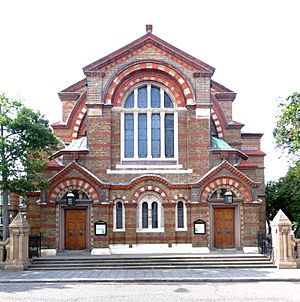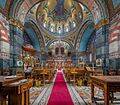Saint Sophia Cathedral, London facts for kids
Quick facts for kids Saint Sophia Cathedral |
|
|---|---|
 |
|
| Location | Bayswater, London, W2 |
| Country | United Kingdom |
| Denomination | Greek Orthodox |
| Website | stsophia.org.uk |
| History | |
| Dedicated | 5 February 1882 |
| Architecture | |
| Heritage designation | Grade I |
| Architect(s) | John Oldrid Scott |
| Style | Byzantine Revival |
Saint Sophia Cathedral (which means "Holy Wisdom" in Greek) is a beautiful Greek Orthodox church. You can find it on Moscow Road in the Bayswater area of London.
This church was officially opened on February 5, 1882. It was built to be a special place for the many Greek families who had moved to London. These families mostly settled around areas like Paddington, Bayswater, and Notting Hill.
Today, the cathedral is a busy place. Besides its regular services on Saturdays and Sundays, it has a Greek choir and teaches Byzantine music. There's also a school where students learn about Greek history, language, and even Greek dancing!
History of Saint Sophia Cathedral
Saint Sophia Cathedral was not the first Greek Orthodox church in London. It was actually the third church to have this name. The earlier churches, located in Finsbury Square and on London Wall, became too small. This was because more and more Greek people were moving to London. Many came from the Greek diaspora, which means Greeks living outside of Greece. Others were visitors who arrived through London's busy shipping routes.
A group of people led by Emmanuel Mavrocordato decided to build the new, larger St Sophia. They worked with others like Demetrius Stefanovich Schilizzi and Edwin Freshfield. The Greek community in London, including many successful merchants and bankers, raised a lot of money for the church. They collected £50,000 in just three years! That was a huge amount of money back then.
The first church service was held on June 1, 1879. This was about 18 months after Eustratios Ralli laid the first stone of the building. The cathedral recently opened a small museum. It shows off special items donated by its early supporters and tells the story of London's Greek community.
In 1922, the Ecumenical Patriarchate of Constantinople, which is like the main leader of many Orthodox churches, chose St Sophia. It became the main cathedral for all Orthodox Christians in the British Isles and Malta.
During World War II, the Greek government had to leave Greece. They set up their government in London. Because of this, St Sophia became the official cathedral for the whole Greek Nation. The church was bombed during the The Blitz, a time when London was heavily attacked from the air. Luckily, it was repaired after the war.
In 2006, a museum opened in the basement of the church. It helps visitors learn more about the cathedral's history.
Architecture and Design
Saint Sophia Cathedral was designed by an architect named John Oldrid Scott. He used a style called Byzantine Revival architecture. This style looks back to the grand churches of the Byzantine Empire, which was an ancient empire in Eastern Europe. John Oldrid Scott designed many important churches in Britain. He also designed St Stephen's Greek Orthodox Chapel in West Norwood Cemetery.
From the outside, the cathedral looks quite simple. You can only really guess its style from the domed roof and arched windows. But when you step inside, it's completely different! The interior is beautifully decorated with colorful marble.
The iconostasis is a special screen covered with religious pictures, called icons. It stands in front of the altar. The icons on this screen were painted by an artist named Ludwig Thiersch. He suggested not painting frescos (wall paintings) on the walls. This was because London's damp weather might damage them. Instead, the church leaders decided to use mosaics. Mosaics are pictures made from tiny pieces of colored glass or stone. These mosaics were made by G M Mercenero & Co, following designs by A G Walker. Later, in 1926, more mosaics were added by another artist, Boris Anrep.
Images for kids





